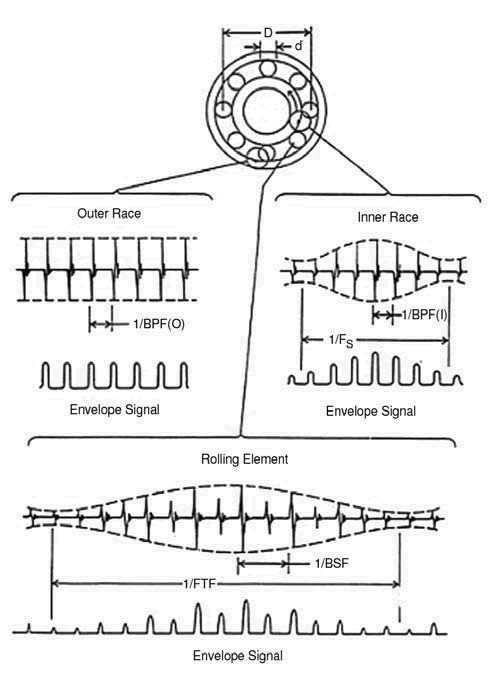Diagnosis of Rolling Element Bearing Faults using Envelope Analysis
Arul Muthukumarasamy & Suri GaneriwalaSpectraQuest Inc., 8227 Hermitage Road, Richmond, VA 23228
Tel: (804)261-3300 www.spectraquest.com
Published: July, 01 2009
Abstract
This technical note focuses on the diagnosis of the localized faults in rolling element bearings using the envelope detection techniques. These bearing faults usually result in strong harmonics of the fault frequencies along with sidebands in the spectrum of the vibration signals. Advanced envelope techniques are developed to identify and analyze the fault frequencies, in order to interpret the type of faults from the results. The envelope signal provides more diagnostic information about the fault frequencies and modulation. Experiments and data acquisition were performed using SpectraQuest's Bearing Prognostics Simulator and examples involving outer and inner race faults are presented.
Keywords: Envelope analysis, Rolling element bearings, Inner and outer race faults
Introduction
The rolling element bearings play a prominent role in today’s machinery. They are widely used in motors, gas turbines, pumps and many other machines. Unlike the long-life fluid bearings, rolling element bearing often encounters metal-to-metal contacts which result in a consequent wear. A series of force impacts are produced when the rollers or balls rolling over a local fault in the bearing that eventually wears out the bearings. Hence, an early detection of any deterioration in the bearing is necessary to avoid major machine failures. So, usually the vibrations signals from the bearings are analyzed and any variations in them due to localized faults are detected to judge the state of the rolling element bearings.
The typical faults in rolling element bearings include corrosion in outer race, inner race and rolling elements, fatigue pitting and cage damage. An impulsive shock is produced exciting the high frequency resonances of the structure of the bearing system, when a fault on the rolling element strikes either the inner or outer race or rolling elements strike a fault on outer or inner race. In case of large machines and large faults, the resonances are excited often lower in frequency than 30 kHz. This impulse incurred while shaft rotating will create a modulating phenomenon. The periodicity and amplitude of the impulses depend on the shaft speed, location of the defect, geometry of the bearing and type of bearing load. The bearing fault frequencies can be categorized as BPFO (ball passing frequency outer race), BPFI (ball passing frequency inner race), BTF (ball fault frequency), and FTF (fundamental train frequency), whose calculations are shown in the appendix [1].
Figure 1 shows the acceleration signals and the envelope signals (by amplitude demodulation) produced by faulty components of a rolling element bearing. Inner race faults are typically modulated by the shaft speed that is the rate at which they pass through the load zone as illustrated in Figure 1. Likewise, the rolling element faults are modulated by the cage speed or fundamental train frequency (FTF). Outer race faults are not modulated as they tend to occur usually in the load zone. Also, the ball fault strikes the outer or inner race which results in two shocks per basic period as defined by the ball spin frequency (BSF).

Fig 1: Acceleration and envelope signals from localized faults in rolling element bearings (Adapted from [1])
The faults in a defective rolling bearing signal are difficult to diagnose through a simple FFT spectrum analysis as they are cyclo-stationary (periodically time-varying statistics), have very little energy and overwhelmed by noise and other vibrations. Also, the resonances enhance higher frequencies and any jitter removes the high frequencies in raw signal but showing them in the envelope. Hence several signal envelope demodulation techniques have been introduced to analyze these bearing signals.





